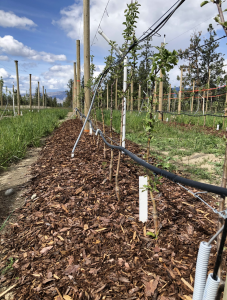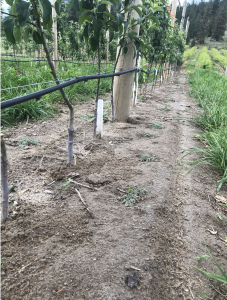Project leads : Sebastian Damin
Project personnel: Shawn Kuchta
Supervisor: Dr. Kirsten Hannam, Dr. Sean Smukler
Project funding:
Land Acknowledgment
We respectfully acknowledge that the lands on which the experimental orchards at the Summerland Research and Development Centre where this research is currently being undertaken lies within the traditional and unceded territories of the Sylix “Okanagan” Indigenous Peoples.
Overview
Orchards are particularly amenable to carbon capture because they are rarely tilled and they grow woody perennial plants (e.g., fruit trees). In the Okanagan Valley, orchards are typically divided into alternating strips of ‘crop rows’ (where fruit trees are actively managed and the soil surface is kept bare using herbicide) and ‘drive rows’ (where the soil surface is protected by grasses and/or other weeds). Soil organic carbon (SOC) is usually higher in the drive rows than in the adjacent crop rows. This presents two interesting questions.
Study 1
Can the soil in orchard crop rows be managed to increase SOC?
There are numerous possible ground cover management methods that can be used to increase SOC in orchard crop rows. These include: (1) maintenance of a cover crop and (2) surface applications of a carbon-rich mulch. Because the Okanagan Valley is already severely water-stressed, any practices aimed at promoting SOC capture must not significantly increase irrigation water requirements. Maintenance of a cover crop in the soil beneath crop trees is widely believed to increase water use by promoting water loss via transpiration from plant leaves. By contrast, organic surface mulches are believed to reduce water use by slowing evaporative water loss from the soil surface. However, the effect of these treatments on plant water stress have been adequately quantified in an Okanagan context.
Research questions:
- Can surface applications of wood chip mulch or maintenance of a woolly thyme cover crop increase SOC in the crop rows of an Okanagan orchard?
- How do surface applications of wood chip mulch or maintenance of a woolly thyme cover crop affect water stress in fruit trees?
Research sites and design:
In the summer of 2021 a new apple orchard was established at the Summerland Research and Development Centre to address these questions. The orchard is planted in a randomized complete block design with six rows (blocks) of measurement trees (n=6); each row is split into three plots, to which one of three ground cover treatments has been randomly assigned: (1) a control treatment, managed conventionally via regular applications of herbicide); (2) a green mulch treatment, which has been planted to woolly thyme; and (3) a wood chip mulch treatment, in which the soil is covered with a layer of bark and wood chips.
Measurements and data collection include:
- Soil moisture
- Soil organic carbon (particulate organic carbon and mineral-associated organic carbon)
- Stomatal conductance, transpiration and photosynthesis rates
- Stem water potential
Study 2
How resilient is the SOC in drive rows to climate warming?

Recent climate projections suggest that average summer temperatures in the Okanagan Valley will rise by approximately 3-6°C by 2050. Increased warming can promote the decay of SOC, which could undermine efforts to mitigate climate change via soil carbon sequestration. Open Top Chambers (OTC’s) are widely used in ecological studies to examine soil, plant, insect and microbial responses to climate warming; these chambers function as small greenhouses, increasing soil surface temperatures by 2-3°C. OTCs were installed in two apple orchards (one irrigated with drippers and one irrigated with microsprinklers) to examine the resiliency of the SOC in orchard drive rows to a warmer climate.
Research questions:
- How do OTCs, placed on the soil surface in orchard drive rows, alter soil microclimatic conditions?
- Do changes in the microclimate of orchard drive row soils, imposed via OTCs, cause changes in SOC dynamics?
Research sites and design:
The drive rows in two adjacent orchards (a drip-irrigated Ambrosia orchard and a microsprinkler-irrigated Fuji orchard) at the Summerland Research and Development Centre are being used in this study. Eight pairs of +OTC and –OTC locations were established in the larger Ambrosia block (n=8) and six pairs of +OTC and –OTC locations were established in the smaller Fuji block (n=6) in completely randomized designs.
Measurements and data collection include:
- Air temperature and humidity
- Soil moisture
- Soil organic carbon (particulate organic carbon and mineral-associated organic carbon)
- Litter decay rate
- Plant diversity

